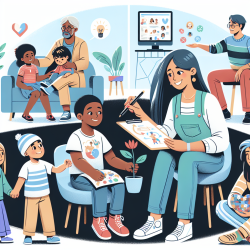As a Special Education Director, I am constantly exploring innovative solutions to better support our students. One such innovation that has proven to be a game-changer is virtual therapy. This blog aims to provide school social workers with an informed perspective on how virtual therapy is transforming student support services.
In recent years, the demand for effective and accessible therapy services in schools has surged. With therapist staffing shortages becoming a critical issue, virtual therapy has emerged as a viable solution. It offers a flexible, efficient, and often more affordable way to ensure that students receive the support they need.
Benefits of Virtual Therapy
Virtual therapy, also known as teletherapy, offers numerous benefits for both students and school social workers:
- Accessibility: Virtual therapy breaks down geographical barriers, making it possible for students in remote or underserved areas to access high-quality therapy services.
- Flexibility: Scheduling virtual therapy sessions is often more flexible than in-person sessions, accommodating the varied schedules of students and therapists alike.
- Cost-Effectiveness: Virtual therapy can reduce costs associated with travel and physical infrastructure, making it a budget-friendly option for schools.
- Consistency: Virtual therapy ensures continuity of care, as students can continue their sessions even if they move or change schools.
- Engagement: Many students find virtual therapy engaging and comfortable, as it often incorporates interactive tools and technology.
Implementing Virtual Therapy in Schools
For school social workers considering the implementation of virtual therapy, here are some key steps to follow:
- Assess Needs: Conduct a thorough assessment of your school's needs and the specific requirements of your student population.
- Choose a Provider: Select a reputable virtual therapy provider, such as TinyEYE, that offers a range of services tailored to school settings.
- Ensure Compliance: Ensure that the chosen provider complies with all legal and regulatory requirements, including data privacy and security standards.
- Train Staff: Provide training for school staff on how to effectively integrate virtual therapy into their support services.
- Monitor Progress: Continuously monitor and evaluate the effectiveness of virtual therapy services, making adjustments as needed to meet the evolving needs of students.
Addressing Common Concerns
While virtual therapy offers many benefits, it is important to address common concerns that school social workers may have:
- Technology Issues: Ensure that both students and therapists have access to reliable internet connections and the necessary devices to participate in virtual sessions.
- Privacy and Confidentiality: Choose a virtual therapy provider that prioritizes privacy and confidentiality, using secure platforms and adhering to HIPAA regulations.
- Engagement Levels: Employ strategies to keep students engaged during virtual sessions, such as incorporating interactive activities and regularly checking in with them.
The Future of Student Support
As we look to the future, it is clear that virtual therapy will continue to play a significant role in supporting students' mental health and well-being. By embracing this innovative approach, school social workers can ensure that all students have access to the care they need, regardless of location or circumstance.
At TinyEYE, we are committed to providing high-quality virtual therapy services to schools, helping to bridge the gap and address therapist staffing shortages. Our goal is to empower school social workers with the tools and resources they need to make a positive impact on students' lives.
If you are curious about how virtual therapy can benefit your school, we invite you to explore our services and learn more about the opportunities available in telepractice jobs. Together, we can create a brighter future for our students.










